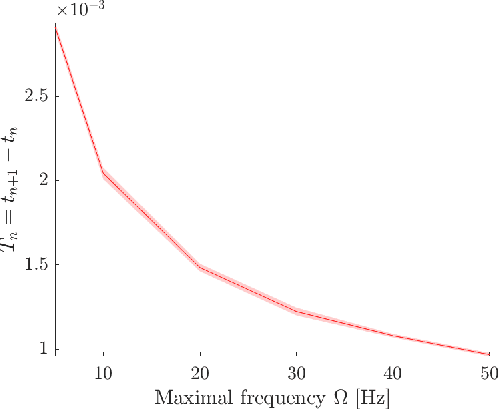Hila Naaman
ECG-TEM: Time-based sub-Nyquist sampling for ECG signal reconstruction and Hardware Prototype
May 22, 2024



Abstract:Portable heart rate monitoring (HRM) systems based on electrocardiograms (ECGs) have become increasingly crucial for preventing lifestyle diseases. For such portable systems, minimizing power consumption and sampling rate is critical due to the substantial data generated during long-term ECG monitoring. The variable pulse-width finite rate of innovation (VPW-FRI) framework provides an effective solution for low-rate sampling and compression of ECG signals. We develop a time-based sub-Nyquist sampling and reconstruction method for ECG signals specifically designed for HRM applications. Our approach harnesses the integrate-and-fire time-encoding machine (IF-TEM) as a power-efficient, time-based, asynchronous sampler, generating a sequence of time instants without the need for a global clock. The ECG signal is represented as a linear combination of VPW-FRI pulses, which is then subjected to pre-filtering before being sampled by the IF-TEM sampler. A compactly supported robust filter with a frequency-domain alias cancellation condition is used to combat the effects of noise. Our reconstruction process involves consecutive partial summations of discrete representations of the input signal derived from the series of time encodings, further enhancing the accuracy of the reconstructed ECG signals. Additionally, we introduce an IF-TEM sampling hardware system for ECG signals, implemented using an analog filter device. The firing rate is 42-80Hz, equivalent to approximately 0.025-0.05 of the Nyquist rate. Our hardware validation bridges the gap between theory and practice and demonstrates the robust performance and practical applicability of our approach in accurately monitoring heart rates and reconstructing ECG signals.
Hardware Prototype of a Time-Encoding Sub-Nyquist ADC
Jan 05, 2023Abstract:Analog-to-digital converters (ADCs) are key components of digital signal processing. Classical samplers in this framework are controlled by a global clock. At high sampling rates, clocks are expensive and power-hungry, thus increasing the cost and energy consumption of ADCs. It is, therefore, desirable to sample using a clock-less ADC at the lowest possible rate. An integrate-and-fire time-encoding machine (IF-TEM) is a time-based power-efficient asynchronous design that is not synced to a global clock. Finite-rate-of-innovation (FRI) signals, ubiquitous in various applications, have fewer degrees of freedom than the signal's Nyquist rate, enabling sub-Nyquist sampling signal models. This work proposes a power-efficient IF-TEM ADC architecture and demonstrates sub-Nyquist sampling and FRI signal recovery. Using an IF-TEM, we implement in hardware the first sub-Nyquist time-based sampler. We offer a feasible approach for accurately estimating the FRI parameters from IF-TEM data. The suggested hardware and reconstruction approach retrieves FRI parameters with an error of up to -25dB while operating at rates approximately 10 times lower than the Nyquist rate, paving the way to low-power ADC architectures.
Time-Based Quantization for FRI and Bandlimited signals
Oct 05, 2021



Abstract:We consider the problem of quantizing samples of finite-rate-of-innovation (FRI) and bandlimited (BL) signals by using an integrate-and-fire time encoding machine (IF-TEM). We propose a uniform design of the quantization levels and show by numerical simulations that quantization using IF-TEM improves the recovery of FRI and BL signals in comparison with classical uniform sampling in the Fourier-domain and Nyquist methods, respectively. In terms of mean square error (MSE), the reduction reaches at least 5 dB for both classes of signals. Our numerical evaluations also demonstrate that the MSE further decreases when the number of pulses comprising the FRI signal increases. A similar observation is demonstrated for BL signals. In particular, we show that, in contrast to the classical method, increasing the frequency of the IF-TEM input decreases the quantization step size, which can reduce the MSE.
FRI-TEM: Time Encoding Sampling of Finite-Rate-of-Innovation Signals
Jun 15, 2021



Abstract:Classical sampling is based on acquiring signal amplitudes at specific points in time, with the minimal sampling rate dictated by the degrees of freedom in the signal. The samplers in this framework are controlled by a global clock that operates at a rate greater than or equal to the minimal sampling rate. At high sampling rates, clocks are power-consuming and prone to electromagnetic interference. An integrate-and-fire time encoding machine (IF-TEM) is an alternative power-efficient sampling mechanism which does not require a global clock. Here, the samples are irregularly spaced threshold-based samples. In this paper, we investigate the problem of sampling finite-rate-of-innovation (FRI) signals using an IF-TEM. We provide theoretical recovery guarantees for an FRI signal with arbitrary pulse shape and without any constraint on the minimum separation between the pulses. In particular, we show how to design a sampling kernel, IF-TEM, and recovery method such that the FRI signals are perfectly reconstructed. We then propose a modification to the sampling kernel to improve noise robustness. Our results enable designing low-cost and energy-efficient analog-to-digital converters for FRI signals.
 Add to Chrome
Add to Chrome Add to Firefox
Add to Firefox Add to Edge
Add to Edge